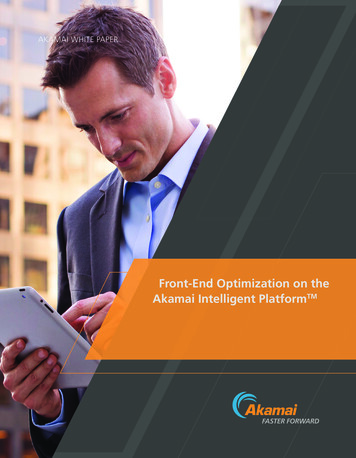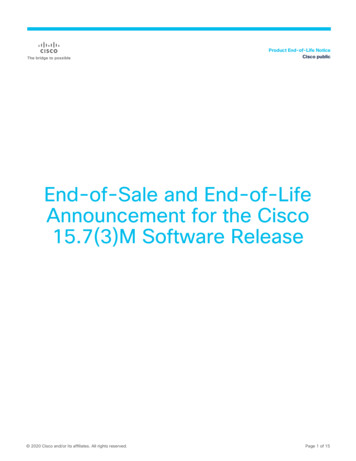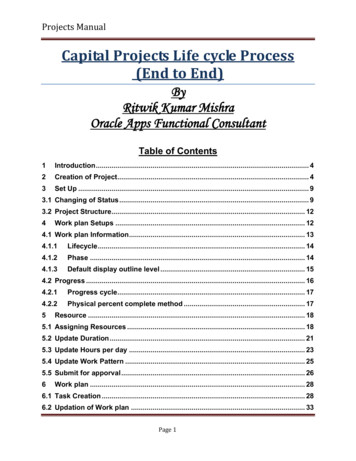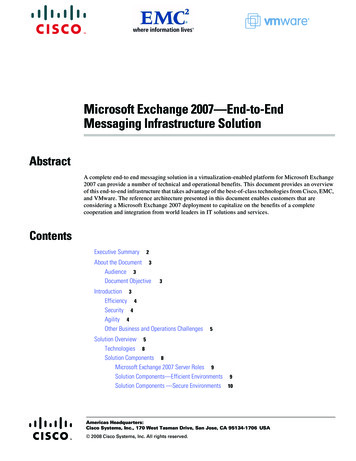
Transcription
AKAMAI WHITE PAPERFront-End Optimization on theAkamai Intelligent PlatformTM
TABLE OF CONTENTSINTRODUCTION. . . . . . . . . . . . . . . . . . . . . . . . . . . . . . . . . . . . . . . . . . . . . . . . . . . . . . . . . . . . . . 1WHAT IS FRONT-END OPTIMIZATION?. . . . . . . . . . . . . . . . . . . . . . . . . . . . . . . . . . . . . . . . . . . . 2FEO IMPLEMENTATION AND CHALLENGES. . . . . . . . . . . . . . . . . . . . . . . . . . . . . . . . . . . . . . . . 4Automated Front-End Optimization. . . . . . . . . . . . . . . . . . . . . . . . . . . . . . . . . . . . . . . . . . 4FRONT-END OPTIMIZATION WITH AKAMAI. . . . . . . . . . . . . . . . . . . . . . . . . . . . . . . . . . . . . . . 5Overview: How it Works. . . . . . . . . . . . . . . . . . . . . . . . . . . . . . . . . . . . . . . . . . . . . . . . . . . 5Asynchronous Analysis Delivers Speed. . . . . . . . . . . . . . . . . . . . . . . . . . . . . . . . . . . . . . . . 6Adaptively Optimized for Each End user. . . . . . . . . . . . . . . . . . . . . . . . . . . . . . . . . . . . . . . 6Overcoming Bottlenecks From End to End. . . . . . . . . . . . . . . . . . . . . . . . . . . . . . . . . . . . . 7Mobile Performance Optimizations. . . . . . . . . . . . . . . . . . . . . . . . . . . . . . . . . . . . . . . . . . . 8BENEFITS OF FRONT-END OPTIMIZATION WITH AKAMAI. . . . . . . . . . . . . . . . . . . . . . . . . . . . . 9Offload the Headache. . . . . . . . . . . . . . . . . . . . . . . . . . . . . . . . . . . . . . . . . . . . . . . . . . . . . 9Rely on a Proven Platform. . . . . . . . . . . . . . . . . . . . . . . . . . . . . . . . . . . . . . . . . . . . . . . . . . 9The Best Experience for Every User, Every Time. . . . . . . . . . . . . . . . . . . . . . . . . . . . . . . . . 9APPENDIX. . . . . . . . . . . . . . . . . . . . . . . . . . . . . . . . . . . . . . . . . . . . . . . . . . . . . . . . . . . . . . . . . 10SOURCES . . . . . . . . . . . . . . . . . . . . . . . . . . . . . . . . . . . . . . . . . . . . . . . . . . . . . . . . . . . . . . . . . 14
Front-End Optimization on the Akamai Intelligent Platform1IntroductionIn the hyperconnected world, web and mobile application performanceis playing a more critical role than ever in driving user adoption andengagement. Today’s savvy audiences demand richer, more interactiveexperiences that require more data and more processing. This is a trendof ever-increasing average web sizes. Yet consumers continue to expectpages to load faster than ever before, indiscriminately abandoning sluggishsites. At the same time, studies have repeatedly shown that enhancing siteperformance brings about greater page views, better audience engagement,higher conversion rates, and even improved SEO rankings.2 Indeed, as little asa few tenthsof a second can make a difference.3Unfortunately, understanding website performance is no small task, particularly as the Internetand the applications running across it become more and more complex. Today, a surprisingly largenumber of factors – including network latencies, communications protocols, device capabilitiesand browser page rendering behaviors – play a role in determining the end user perception ofwebsite performance.Traditionally, web performance tuning efforts focused on the application back end. This is the areaover which web developers have the greatest control, but unfortunately, changes made here maynot translate into big improvements for the end user. This is because back-end time – which includesthe overhead involved in making database calls and generating the HTML page – actually accountsfor only about 10% of user-perceived page load time for the typical web application today. Theremaining 90% is due to middle mile and front end latencies. The middle mile refers to the timeit takes for data to travel across the Internet, which can face significant delays due to networklatency, routing problems, and Internet congestion. The front end includes the time it takes fordata to cross the last mile to the user’s device and then for the browser to render the page.website performance optimization needs to successfully address the 90% problem in orderto deliver the level of responsiveness end users demand.How website page load time breaks down10%Back End orFirst Mile Database calls HTML pagegeneration90%Middle Mile Retrieving page content, (including HTML,images, JavaScript, etc.,) from origin server,across the Internet (the ‘Long-hair’ acrossmultiple networks and peering points)Front End or Last Mile Delivering content over cable modem,cellular network, etc., to end user Rendering page in the browser
Front-End Optimization on the Akamai Intelligent PlatformWhat Is Front End Optimization?As content and application delivery networks have proven effective at helping sites overcomemiddle mile performance issues, front end performance issues are now coming into focus and beingaddressed. Front end bottlenecks play a growing role in overall site performance as today’s rich andcomplex Internet applications make increasing use of embedded objects, sophisticated stylesheets,client side code, and third-party content – all of which slow down the rendering of a page. Mobilesites, with their sluggish networks and weaker device processors, face an even greater front endchallenge. The need to address these types of performance issues has led to increased awarenessabout Front End Optimization (FEO), a set of best practices designed to reduce front end delays inorder to improve the end user experience.FEO techniques can be broadly grouped into four complementary approaches:1. Reduce the number of HTTP requests. Before rendering a web page, browsers first make anHTTP request for the HTML page, followed by requests for additional resources required to displaythe page – such as images, CSS, or JavaScript. The number of requests required for a typical pagehas more than tripled in the last 9 years, to a current average of 100 objects per page.5Unfortunately, each new HTTP request can increase unwanted delay in setting up the connection.For mobile devices, this overhead typically takes more time than downloading the page dataitself. Even for desktop browsers, this overhead is one of the key factors in determining pagerendering times, and reducing the number of requests can greatly improve the user’s perceptionof site responsiveness. FEO employs various techniques to achieve this request reduction, includingconsolidating multiple files into a single request, caching objects locally using HTML5’s ApplicationCache interface, and inlining small objects within the HTML.2. Reduce the size of the data. Page weight is often the single largest factor in page downloadtimes, so reducing the number of bytes transferred can significantly speed up a site. FEO techniques are designed to reduce page weight without changing visual quality or site functionality. Images are typically the biggest component of page weight and can often benefit fromcompression or resizing without compromising quality. Adaptive image compression, whereresizing is optimized based on the end user’s screen resolution and connection speed, is especiallyeffective. Text blocks – such as HTML, JavaScript and CSS files – can also be significantly reducedin size through techniques such as compression and minification, the process of removingunnecessary characters such as whitespace and comments.2
Front-End Optimization on the Akamai Intelligent Platform3. A ccelerate page rendering. Different browsers exhibit different page rendering behaviors,many of which prevent pages from rendering as quickly as possible. For example, browsersoften: Block other downloads while downloading, parsing, and executing scripts. Limit the number of simultaneous requests for images and other embedded content. Olderversions of Internet Explorer and Firefox, for example, are limited to two parallel requests perhostname. Newer versions increase this limit to 6. Block page rendering while stylesheets are downloaded and parsed.F EO techniques address these problems by recoding the HTML in a way that distributes thebrowser’s work so that the page can begin to render as soon as possible, delaying nonessentialtasks until later. Techniques include using asynchronous JavaScript execution, which helpsprevent scripts from delaying object downloads and page rendering; just-in-time or on-demandimage loading, which loads only images in the current viewable area, deferring others untilthe user scrolls; and domain sharding, or retrieving objects from multiple subdomains to workaround browser limitations on concurrent requests. While these techniques work well tominimize page rendering bottlenecks, they do need to be customized to each browser’s specificbehaviors. In some cases, we may add code to take advantage of newer browser capabilities,while, in other cases, we may make changes to overcome deficiencies in older browsers.4. Alleviate third-party bottlenecks. Ads, analytics code, social media widgets, and otherthird-party content now represent a large percentage of total page requests. Unfortunately,due to the page rendering behaviors discussed above, sluggish third-party content cansignificantly slow down a page or even make it appear completely unavailable to the enduser, as the browser may block the progress of a page while waiting for the third-partycontent to load.websites have no control over the performance of third-party content, but FEO bestpractices can alleviate these bottlenecks by decoupling the third-party script execution fromthe loading of the page. By making the third-party request asynchronous, FEO ensures thata slow third-party tag will not negatively impact the loading of the other objects and therendering of the page.For an overview of Akamai FEO optimizations please refer to the appendix.3
Front-End Optimization on the Akamai Intelligent PlatformFEO Implementation And ChallengesFEO evolves constantly as browser and device technology continues to change, but it is hardly a black boxor secret art. Indeed, many FEO best practices are well documented across the web on sites like YSlow,PageSpeed, and Steve Souders’ High Performance web Sites blog. In theory, this means any websitedevelopment team can simply implement the techniques and enjoy significant performance improvementsacross its site. The reality, however, can be quite different.First, FEO is complex, making it difficult to implement and costly to maintain. The up-front investmentrequired to manually retrofit an existing site for FEO can be on the order of many man-years – not including the ongoing resources needed to keep the site optimized. Moreover, unless all members of thedevelopment team gain FEO expertise, any implemented optimizations may be lost each time the site itselfis changed or redesigned.Second, FEO best practices are not one-size-fits-all. Different approaches are relevant in different situations,and if used incorrectly, FEO techniques can actually hurt performance. For example, domain sharding maywork well for desktop browsers running on fast connections, but it may hurt performance in certain mobile scenarios. The ideal number of domains to use also depends on multiple factors.Generally, FEO techniques involve balancing tradeoffs among many different considerations. For instance,one might assume that inlining all content – that is, requesting all page resources in a single download –is ideal for performance, because it reduces HTTP requests down to one. In reality, this is not optimal formost situations, as you lose the often-greater performance benefits of being able to cache images or usejust-in-time image loading to reduce page download size and accelerate page rendering. The balancingpoint between these tradeoffs can be a complex and moving target, as browser, devices and networksevolve – and proliferate – at a rapid pace. Trying to keep site optimizations up to date in the face of neverending changes, both in the device/browser landscape and within the application itself – is a daunting andexpensive proposition.Automated Front End OptimizationIn an attempt to address some of the challenges associated with manual FEO implementation, a cropof young companies are now providing automated FEO technologies, available either as an applianceto be deployed in front of a site’s servers, or as a service that intercepts and responds to requests onbehalf of the site. These FEO technologies attempt to tackle only the front end piece of the overallperformance puzzle; they do not address network latency, congestion, and reliability issues that canseverely hamper the delivery of any website or application, for example. However, they can work inconjunction with content and application delivery networks to provide a more comprehensive solution.Unfortunately, both appliance and service-based FEO solutions often become bottlenecks of theirown. Automated FEO solutions sit in the line of fire, taking the HTML code generated by a site andmodifying it before delivering it to the end user. Being in the critical path, the reliability, scalability andperformance of the FEO solution is paramount. For service-based solutions, the website is at the mercyof its service provider. For appliance-based solutions, the website must architect and plan for capacityand failover as well as maintain their new boxes. Either way, there is a cost and risk associated.In addition, these FEO solutions often have integration or compatibility issues with the othercomponents of the website’s overall performance strategy, such as the content or application deliverynetwork. When cobbling together two disparate solutions, companies are left to fend for themselves ifsomething goes wrong, troubleshooting in the no-man’s land in between the cracks. These situationscan create support nightmares for the site, particularly with a technology that modifies website codeon the fly. Thus, while stand-alone automated FEO solutions have the potential to provide someperformance benefits without the high cost of manual FEO coding, they also carry a number of risksthat make them far from ideal.4
Front-End Optimization on the Akamai Intelligent Platform5Front End Optimization With AkamaiAkamai takes an end-to-end approach to solving website performance, offering a cohesive,multi-layered performance solution designed to help businesses overcome origin, middle mile, andfront end bottlenecks automatically and effortlessly. For every end user request, Akamai’s proventechnologies are dynamically applied in a way that optimizes performance for that unique scenario,taking into account real-time website, network, and end user conditions. Akamai’s FEO capabilitiesare an integrated part of these solutions, working in concert with our other performance, security,and availability offerings to deliver the best possible experience for every user, on every device,every time.Akamai’s FEO capabilities are based on advances pioneered by Blaze, an industry-leading FEOcompany that Akamai acquired in early 2012. Blaze’s cutting-edge FEO solution was designedfrom the ground up to work in synergy with a distributed content and application delivery network,providing an ideal architecture for incorporation into the Akamai Intelligent Platform. Built on thisfoundation, Akamai is now able to offer a uniquely robust and scalable automated FEO solutionas a seamlessly integrated part of our comprehensive web performance solutions.Overview: How it WorksIn the diagrams below, we illustrate how Akamai’s FEO works:Application OriginPart I. First Request1. User requests a page2. No front end optimizationsare available2341FEO Analysis4. Subsequently, page is queuedwith the FEO Analysis Engineto be analyzedApplication OriginPart II. Offline Analysis21FEO Analysis3. Page is accelerated acrossthe middle mile and deliveredto first-request user withoutfront end optimizations1. FEO Analysis Engine evaluatespage to determine the bestways to optimize it, andproduces optimizedtransformation rules2. FEO Analysis Engine makesoptimized transformation rulesavailable across the AkamaiIntelligent Platform
Front-End Optimization on the Akamai Intelligent Platform6Application OriginPart III. Subsequent Requestsand Continued Analysis1. A nother user requeststhe page23FEO Analysis12. Akamai applies the pre-created front end optimizationsand delivers acceleratedpage with front endoptimizations applied3. Page is continuouslymonitored and re-analyzedAs always, end user requests are efficiently routed to a nearby Akamai server. This server may be ableto deliver the requested content straight from cache or will fetch it from the origin server using route,protocol, and application optimizations to accelerate delivery over the long-haul Internet. The serveralso applies the relevant front end optimizations before delivering the content to the end user, whichenables speedy page rendering. The end result is an exceptional end user experience that is rich, reliable, and responsive, regardless of device or Internet conditions.Asynchronous Analysis Delivers SpeedUnderstanding which front end optimizations to apply to a dynamic site requires complex andcomputationally intensive analysis. Our sophisticated, offline analysis engine does this workasynchronously, precomputing transformations to be applied to the various static and dynamicallygenerated pages of a site. This information is then provided to servers across the Akamai IntelligentPlatform, allowing them to rapidly apply the transformations in real time as they deliver content to endusers. By separating the complex analysis from the real-time application of the optimizations, Akamaidelivers cutting-edge FEO capabilities without sacrificing speed.Adaptively Optimized for Each End-UserTo be effective, FEO optimizations need to be customized for the end user environment, becausedifferent browsers and devices behave differently. For example, browsers differ in their supportfor features like asynchronous JavaScript, HTTP pipelining or the number of simultaneous downloadsthey can make, suggesting different optimization behaviors. Images may also be resized differentlyfor different devices and screen resolutions. In addition, a device connected over a loss-y, high-latency3G network may benefit from different types of optimizations than a device running over a fastInternet connection.Akamai’s platform handles these different situations seamlessly, creating multiple possible optimizations in the analysis phase, and then intelligently applying the appropriate ones to each request basedon real-time factors such as the end user’s browser version, device and network speed. This means wetake advantage of the full capabilities of each user’s specific setup to deliver the best possible experience – rather than simply settling for the lowest common denominator supported across all browsers– or targeting only the most popular browsers while leaving other users out in the cold.
Front-End Optimization on the Akamai Intelligent PlatformMoreover, Akamai continually updates and improves its optimization engine to reflect thestate-of-the-art in FEO innovations as well as the constantly evolving browser and devicelandscape. This enables our custome
Front-End Optimization on the Akamai Intelligent Platform 4 FEO Implementation And Challenges FEO evolves constantly as browser and device technology continues to change, but it is hardly a black box or secret art. Indeed, many FEO best practices are well documented across the web on sites like YSlow,











